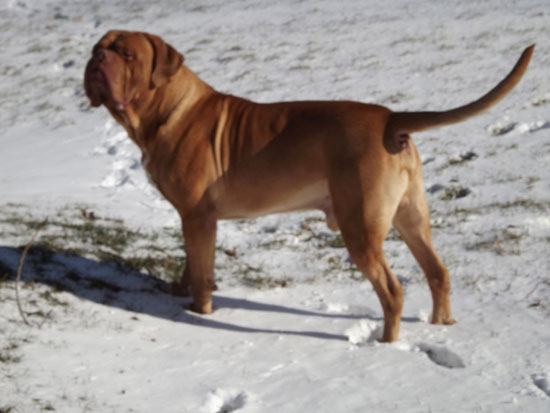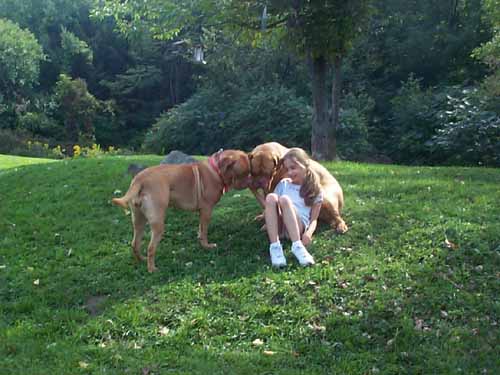
|
 |
|
Dogue de Bordeaux
|
The Dogue de Bordeaux is probably one of the most
ancient French breeds, though it only became known
by this name in the second part of the nineteenth
century Gaston Phe'bus, the Count of Foix, whose
book about gun dogs is famous, wrote in the 14th
century about the "alans vautres" which were the
ancestors of the Dogues de Bordeaux.
|

|
|
HISTORY OF THE BREED
|
|
Somewhat disappointingly, few historical
details about the Dogue de Bordeaux exist before
1863. In earlier days, this dog was called a Dogue
or a Matin. This latter name comes from the same
root as the word 'Mastiff' which is why the Dogue de
Bordeaux is sometimes called a French Mastiff. The
first reference by name appeared in a French show
catalogue in that year; when one specimen of the
breed was exhibited. The purpose of this show was
more to exhibit different breeds than to judge dogs
against their Standard. By the end of the century,
the name Dogue de Bordeaux was better established.
In the old days, Dogues de Bordeaux were kept for
all sorts of jobs: hunting, fighting, guarding, and
pulling loads. Butchers used them to prevent steers
getting away and to keep them in their place and
also for pulling loads of meat from the
slaughterhouse to their shops. During the First
World War; some Dogues de Bordeaux helped to drag
injured people to safety Another task given them was
hunting animals such as boars. Unfortunately, Dogues
were also involved in deplorable dog-baiting
spectacles where they were made to fight with other
dogs, or even bears or bulls, simply for man's
entertainment. It is sad to say that not only Dogues
de Bordeaux were thus treated -many Molossers went
through this cruel ordeal.
|
|
GENERAL APPEARANCE
|
| Typical
concave lined brachycephalic molossoid. The Dogue de
Bordeaux is a very powerful dog, with a very
muscular body yet retaining a harmonious general
outline. He is built rather close to the ground, the
distance from sternum to ground being slightly less
than the depth of the chest. Stocky, athletic,
imposing, he has a very dissuasive aspect.
|
|
|
BEHAVIOR AND TEMPERAMENT
|
An
ancient fighting dog, the Dogue de Bordeaux is
gifted at guarding, which he does with vigilance and
great courage, but without aggressiveness. A good
companion, very attached to his master and very
affectionate. Calm, balanced with a high stimulus
threshold. The male normally has a dominant
character.
|
|
A FINAL COMMENT
|
As with
all short-faced Molossers, the Dogue de Bordeaux is
one of those dogs which has always had close links
with man, one of those dogs used by man for guarding
and hunting as well as for fighting in wars or
against other animals, one of those dogs whose look
alone is enough to deter. That this kind of dog may
have descended from the prehistoric short-faced
Borophagus or Aelurodon rather than a wolf or a
jackal is a tempting hypothesis. This unfortunately
remains an unproved part of the legend. But it is
certain that this kind of dog, unlike many which
tend to form packs, turns more readily to man. As
Raymond Triquet puts it, the Dogue de Bordeaux has a
sour mug but a golden heart. This, along with an
expression of tenderness and sweetness, makes it
irresistible.
|

|
|
ACKNOWLEDGEMENTS
|
|
Some of the information on this page is from "THE DOGUE DE BORDEAUX" by Anne-Marie Class, found in chapter 12 starting on page 195 in the book
The Ultimate Book of Mastiff Breeds edited by Douglas Oliff, published by: HOWELL BOOK HOUSE, A Macmillian Company, 1633 Broadway, New York, NY 10019
|
|


